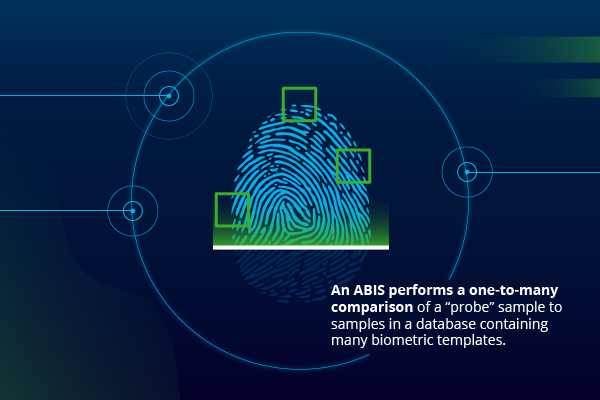An automated biometric identification system, or ABIS, is used for large-scale biometric identification and deduplication. An ABIS is a type of biometric search system that performs a one-to-many comparison of a “probe” sample to samples in a database containing many biometric templates. This process is known as biometric identification. It enables matching of a live sample against many existing biometric templates to find a record of a particular individual and verify his or her identity.
Biometric identification is not the same as the one-to-one verification – one biometric template, one user sample – used in authentication models. Biometric identification answers the question “Who are you?” Biometric verification answers the question, “Are you really you?”.
An example of biometric identification is searching a biometric database using a newly taken mugshot during a police booking to see if that individual is already registered. An example of biometric verification is using Face I.D. to unlock a smartphone.
How ABIS works
An ABIS compares biometric identifiers such as a fingerprint, face, or iris belonging to an individual to existing samples, also known as biometric templates, in a biometric database.
Each person’s fingerprint, face, and iris has unique characteristics. This makes it possible to associate biometric identifiers with a single person. A biometric search uses algorithms that compare the physical characteristics in a probe sample to the characteristics in existing templates.
The probe sample used in the search can be collected with an individual’s knowledge by way of a fingerprint scan, photograph or mugshot, or iris scan in an arrest booking or as part of a voluntary enrollment process.
Alternatively, it can be collected as a latent sample in a forensic investigation.
Biometric templates in a gallery are the samples collected during law enforcement bookings, or registered as part of a civil enrollment process. Technically, a biometric template can also be created for an unknown individual – for example, in criminal investigations where investigators lift a fingerprint from a crime scene. Creating a new template for that latent print makes it possible to match fingerprints from different crime scenes and future enrollments. Biometric searches using latents can be used to place the same individual at two different crime scenes, even if that person’s identity is unknown.
History of ABIS
The earliest example of an ABIS is the “Automated Fingerprint Identification System” (AFIS). The FBI created AFIS in the 1980s. “AFIS” – and “ABIS” – are now used as more general descriptors rather than a single system. An ABIS performs that same function as an AFIS but can search using multiple types of biometrics. Modalities extend beyond fingerprints to face and iris.
AFIS became IAFIS (Integrated Automated Fingerprint Identification System) in 1999 when the system was enabled with the ability to be searched by organizations outside the FBI. Roughly 18,000 local, state, tribal, federal, and international partners now access IAFIS.
In 2004, the Department of Defense implemented the first ABIS to track and identify national security threats. By 2005, DoD had made IAFIS and ABIS interoperable to consolidate and simplify one-to-many biometric searches.
While ABIS technology was initially developed for law enforcement applications, their uses have broadened considerably beyond law enforcement and even beyond government.
Public sector use cases
Today, there are two primary types of ABIS used in the public sector:
Criminal ABIS
The key differentiating feature of a criminal ABIS is its ability to process and analyze latent fingerprints (those left behind at a crime scene) and compare them against an existing database of fingerprint samples. Nowadays, video surveillance can also be collected for comparison against existing facial image samples, e.g. “mug shots.” Law enforcement agencies enroll biometric data from criminal suspects as part of a booking process. In an investigation, they can use examiner workstation applications to prepare biometric information for search and to help interpret and refine results.
Civil ABIS
A civil ABIS is not used for criminal investigation, and so the ability to submit latent fingerprints or video surveillance footage for search is not included. Use cases for civil ABIS generally involve the voluntary submission of biometrics as part of an enrollment process. Border management is an example. These biometrics can also be submitted for search law enforcement systems. For instance, a civil ABIS can be used to ensure that a visa applicant is not in a criminal database. Civil ABIS is also useful as an identity-proofing measure toward benefits-fraud prevention. Specifically, it prevents an individual with an existing identity from creating a false alias by collecting a fingerprint sample or performing a scan via a facial recognition system at the time of enrollment.
In recent decades, government agencies in the United States and abroad have ramped up efforts to create interoperability between criminal and civil biometric search systems. For example, the U.S. Department of Homeland Security manages a civil ABIS called IDENT that is used for immigration. After 9/11, DHS worked with the Department of Justice to enable data sharing between IAFIS and IDENT. This means a biometric search can now flag an individual who is registered in IAFIS.
Private sector use cases
Some examples of ABIS use cases in the private sector include:
Healthcare
In some countries, ABIS is used to determine a patient’s identity prior to care delivery. The World Health Organization (WHO) has suggested that the implementation of biometric technologies can improve patient verification worldwide, especially in developing countries where patients may be less likely to carry a form of civilian ID.
Enterprise
ABIS can also be used by enterprises as they perform identity checks as part of the onboarding process for new customers or employees. Biometrics can be used to definitively determine if an applicant is already registered in the system, perhaps with different biographic information. Applicant’s biometrics can also be used for search against a criminal database.
Aware products for ABIS
- AwareABIS: Automated biometric identification system.
- WorkbenchSuite: Optional add-on forensic analysis applications to AwareABIS.
Click here to learn more about Aware’s portfolio of biometric products and services.




